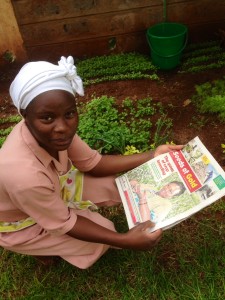 Yes, I know blogging has been slow the past week or so, but I’ve been on leave and Jeremy way too busy with work for everyone’s good, though mostly his. But look, you got couple of big fat Brainfoods to keep you going, no? ((Oh, and BTW, if that paper on oxygen and seed longevity was of interest, stay tuned, I’ve got a treat in store for ya…)) Anyway, thought you might be interested in this piece in Kenya’s Saturday Nation newspaper a couple of days back. It’s a profile of AGRA plant breeder Dr Jane Ininda. The illustration is a (poor quality, alas) photo of the actual newspaper, which I took because it was such a treat to see a crop breeder splashed all over a major national newspaper. And the effect is just not the same in the digital version.
Yes, I know blogging has been slow the past week or so, but I’ve been on leave and Jeremy way too busy with work for everyone’s good, though mostly his. But look, you got couple of big fat Brainfoods to keep you going, no? ((Oh, and BTW, if that paper on oxygen and seed longevity was of interest, stay tuned, I’ve got a treat in store for ya…)) Anyway, thought you might be interested in this piece in Kenya’s Saturday Nation newspaper a couple of days back. It’s a profile of AGRA plant breeder Dr Jane Ininda. The illustration is a (poor quality, alas) photo of the actual newspaper, which I took because it was such a treat to see a crop breeder splashed all over a major national newspaper. And the effect is just not the same in the digital version.
Brainfood: Ethiopian coffee, Kenyan climate change, Biofortification, Pasture legume adoption, Moroccan veggies, Economics of pests, Grassland diversity & fire, Seed storage, Resistant beans, Maize OPVs, Low P tolerance in NERICA, Brazilian beans
- Prospects for forest-based ecosystem services in forest-coffee mosaics as forest loss continues in southwestern Ethiopia. Coffee agroforests provide about half to two thirds of the ecosystem services of plain old forests.
- Social Process of Adaptation to Environmental Changes: How Eastern African Societies Intervene between Crops and Climate. Your seeds may not be able to cut it in the future.
- Bioavailability of iron, zinc, and provitamin A carotenoids in biofortified staple crops. Focus on breeding varieties with elevated micronutrient concentrations is justified. Phew.
- The future of warm-season, tropical and subtropical forage legumes in sustainable pastures and rangelands. Those who cannot remember the past are condemned to repeat it. And the past, in this case, was full of mistakes.
- Wild leafy vegetable use and knowledge across multiple sites in Morocco: a case study for transmission of local knowledge? The Rif Mts are a hotspot of weed diversity. Not that kind of weed, settle down. No, wait…
- Agricultural Trade, Biodiversity Effects and Food Price Volatility. Pests are damaging to neat economic models. Pesticides fix that but damage the environment. No word on the economics of natural enemies, integrated pest management, varietal diversity etc.
- Annual burning drives plant communities in remnant grassland ecological networks in an afforested landscape. In the southern Afromontane region, annual burning does not reduce the species diversity of grassland patches, but does make these patches look more and more alike. Add heavy cattle grazing though and that does reduce diversity.
- Responses to fire differ between South African and North American grassland communities. Decreasing fire frequency increased species diversity in Kansas, decreased it in Kwa-Zulu Natal. It’s because of the rhizomatous species in America. What does this and above mean for crop wild relatives?
- Prolonging the longevity of ex situ conserved seeds by storage under anoxia. Remove oxygen to make seeds last longer in genebanks.
- Identification of Sources of Bacterial Wilt Resistance in Common Beans (Phaseolus vulgaris L.). Only 1 resistant accession out of 500 in the USDA collection. And it’s a wild one.
- Evaluation of Evolution and Diversity of Maize Open-Pollinated Varieties Cultivated under Contrasted Environmental and Farmers’ Selection Pressures: A Phenotypical Approach. OPVs are diverse and change over time. Still no cure for cancer.
- A novel allele of the P-starvation tolerance gene OsPSTOL1 from African rice (Oryza glaberrima Steud) and its distribution in the genus Oryza. Kasalath comes to the rescue of NERICA. Must be the only sativa gene NOT in NERICA.
- Agronomic potential of genebank landrace elite accessions for common bean genetic breeding. Yeah, but are they in the Brazilian genebank? Doesn’t look like it.
Nibbles: Uncommon grains, Wheat model, Yield gains, Cheese bugs, Grapes, Bee biodiversity, Pakistan seed industry, Bangladesh nutrition, Baobab juice
- Could teff or millets topple wheat, maize and rice? Anyone for unintended consequences?
- Not if superior models lead to bigger wheat harvests. ’Cos that’s all it takes.
- That and a good book: Yield Gains in Major U.S. Field Crops.
- Did somebody mention models? Vorarlberger Bergkäse is a model cheese, and “The rind is the boundary layer between a cheese and its environment”. Welcome to the cheese microbiome.
- What’s the difference between a wine grape and a table grape? Simple: Pectic-{beta}(1,4)-galactan, extensin and arabinogalactan-protein epitopes.
- Bee biodiversity results in mo’ bigger blueberries. Now to make use of that.
- Seed policy wonks – you know who you are – will thrill to IFPRI’s new report: The seed industry in Pakistan.
- So how does that square with the Financial Express of Bangladesh’s discovery that “Agro biodiversity can improve nutrition and health”?
- How to make baobab juice. Time to edit those factsheets.
Nibbles: Cowpea blogging, Rice vs wheat psychology, IRRI rice breeding, Wheat disease, African ag success, AGRA seed, Seed certification
- Omnibus edition of recent GCP blog posts on cowpea.
- Chinese rice farmers more sharing and caring than wheat farmers.
- Wonder if that will change with all these fancy new rice varieties coming through.
- Wonder if fusarium ear blight of wheat will change that.
- No such problems in Africa, no sirree.
- Not with all these AGRA-supported seed companies taking off.
- But there’s an international component to that which is being neglected.
Game of Strawberries

As one generation of campus strawberry breeders prepares to pass the torch to another, the commission in October filed a lawsuit against the university, expressing concern that the campus would end its breeding program.
UC Davis’ reply was as loud and clear as a dragon crying out for its Mother:
“UC Davis is committed to a long-term, positive relationship with the Strawberry Commission, for the benefit of California strawberry growers and the public,“ said Helene Dillard, dean of the College of Agricultural and Environmental Sciences. “We are eager to resolve the legal issues and move on to address the many challenges facing the strawberry industry.”
She noted that the college has begun the recruitment process for a new breeder and plant geneticist to join the strawberry program.
To further demonstrate its commitment to maintaining a strong, secure breeding program, the college has made sure that it has two copies of the strawberry plant collection — one for use by the breeders and one to serve as a backup. Each contains patented varieties, advanced selection lines, breeding stock and historical plants.
So is it all a big misunderstanding? Time to return Oathkeeper to its scabbard? Well, there may be a bit more to it than UC Davis allows in its news article. This from an article in The Packer (tag line: Everything Produce) back in January:
The lawsuit alleges that UC-Davis breached its contract with the commission. Among the allegations, the commission says growers are no longer receiving strawberry germplasm specifically developed for them.
The commission wants a judge to stop UC-Davis from allowing two scientists to control and profit from research and cultivars commission members paid for already.
The two scientists have been working on strawberries since the commission’s formal arrangement with the school began in 1980. They are not named as defendants in the case.
According to the commission’s complaint, in early 2012 researchers Doug Shaw and Kirk Larson announced intentions to resign and take the germplasm and research to establish a private company to research and breed strawberries. The university then notified the strawberry commission it planned to terminate the breeding and research program and said it will no longer sell new strawberry varieties to the growers, according to the civil lawsuit.
So it may not be so much about the commitment of UC Davis to the breeding programme, as about the nature of control over its products. We hope the court proceedings — should it go that far — won’t turn into a Red Wedding.